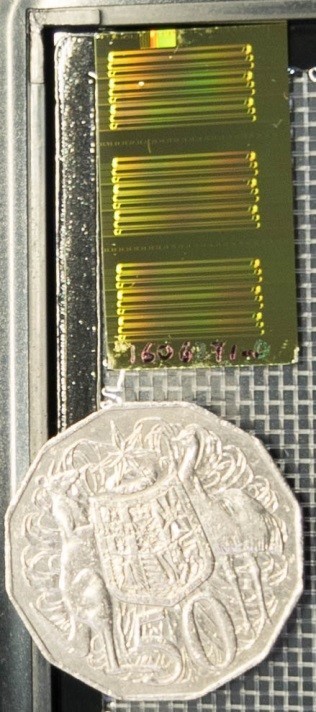Storing photonic information as sound waves

Australian researchers have achieved a massive breakthrough in the field of optical information processing, dramatically slowing digital information carried as light waves by transferring the data into sound waves in an integrated circuit. This allows precious extra time to store, process and then redistribute the data without relying on electronics.
Fibre optics and the associated photonic information — data delivered by light — have huge advantages over electronic information: bandwidth is increased, data travels at the speed of light and there is no heat associated with electronic resistance. Photons, unlike electrons, are also immune to interference from electromagnetic radiation.
However, the advantages of light-speed data have their own problem: you need to slow things down on a computer chip so that you can do something useful with the information. In traditional microchips, this is done using electronics — but as computers and telecommunication systems become bigger and faster, the associated heat is making some systems unmanageable.
Transferring information from the optical to acoustic domain and back again inside a chip is one solution for the development of photonic integrated circuits: microchips that use light instead of electrons to manage data. Moritz Merklein, a doctoral student at the University of Sydney, noted, “For this to become a commercial reality, photonic data on the chip needs to be slowed down so that they can be processed, routed, stored and accessed.”
Merklein and Dr Birgit Stiller, both from the ARC Centre of Excellence for Ultrahigh bandwidth Devices for Optical Systems (CUDOS), have now demonstrated a memory for digital information that coherently transfers between light and sound waves on a photonic microchip. The groundbreaking study co-authored by the researchers has been published in the journal Nature Communications.
“The information in our chip in acoustic form travels at a velocity five orders of magnitude slower than in the optical domain,” said Dr Stiller, describing this delay as “like the difference between thunder and lightning”. This allows for the data to be briefly stored and managed inside the chip for processing, retrieval and further transmission as light waves.
“Our system is not limited to a narrow bandwidth,” added Dr Stiller. “So unlike previous systems this allows us to store and retrieve information at multiple wavelengths simultaneously, vastly increasing the efficiency of the device.”
The researchers used for their experiment a chip that was fabricated at the Australian National University’s (ANU) Laser Physics Centre, also part of CUDOS. The chip is made of chalcogenide glass, which provides optimal guidance of both optical and acoustic waves.
“The high level of performance achieved is the result of 10 years of research at the Laser Physics Centre CUDOS node into materials properties, waveguide device geometry effects and optimised processing methods for chalcogenide glass to produce stable, low-loss, high power handling capacity devices,” said Dr Khu Vu, who fabricated the chip.
The optical acoustic memory system operates at room temperature and can be interfaced with other on-chip components in a straightforward manner, which means it can be easily integrated into photonic circuits. This process eliminates electronic processing steps to some extent and could lead to a paradigm shift in processing technology.
Professor Benjamin Eggleton, CUDOS director and co-author on the study, concluded that the new research marks “an important step forward in the field of optical information processing”, noting that the new concept “fulfils all requirements for current and future generation optical communication systems”.
Nanoscale pixels to advance augmented reality eyewear
Physicists have developed extremely small pixels that can be used in compact AR glasses, using...
Novel semiconductor shows superconducting promise
Researchers from The University of Queensland have demonstrated superconductivity in...
Light-controlled ferroelectrics for future electronics
Researchers have discovered a way to manipulate the properties of ferroelectric materials quickly...





